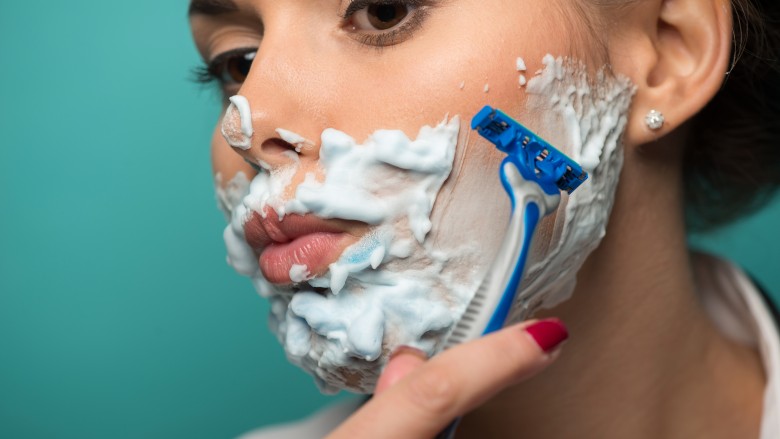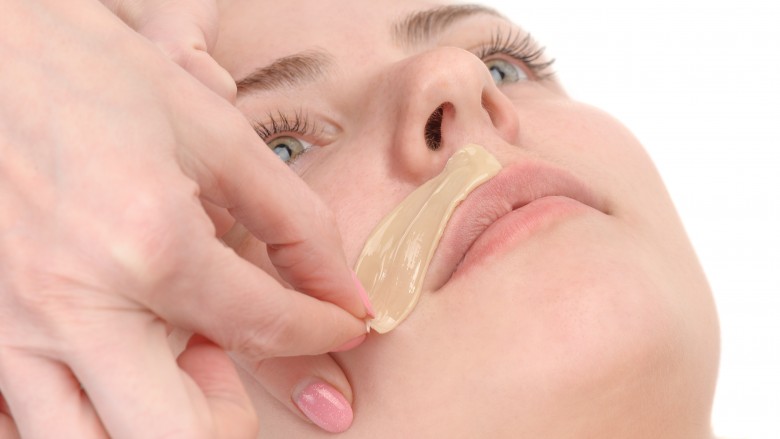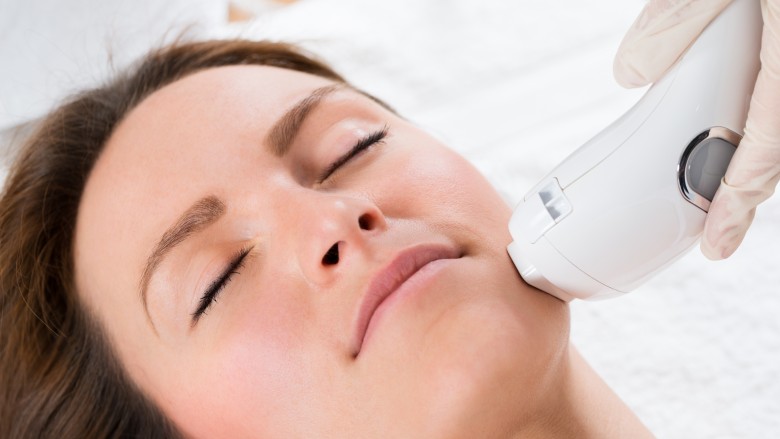Ways To Deal With Facial Hair
We may receive a commission on purchases made from links.
Is there such a thing as a normal amount of facial hair in women? Not exactly. "Normal" amounts of facial hair vary from person to person. Some individuals have very little facial and body hair, while others — women included — can have a fair amount. Facial and body hair are part of our genetic makeup, which means that your genetics can even play a role in in determining your facial hair patterns. Also related to genetics, your ethnicity can also determine whether or not you'll have more facial and body hair than another woman.
Unfortunately for most women, facial and body hair is frowned upon and can even be an embarrassing problem that needs to be solved — permanently. Of course, there are a number of ways to remove body and facial hair, depending on your personal preference. But, if you're experiencing the sudden appearance of excessive facial hair, there are other things to consider before running to the nearest salon.
Shaving
Almost every woman you know likely owns a razor (or two). This is probably why it's one of the most common (and arguably easiest) way to remove unwanted hair from any part of your body, including your face.
While shaving is easy, it isn't permanent. Most old wives' tales also say that if you shave your hair, it will grow back thicker than before, which could discourage someone from trying it, especially if the hair they're looking to remove is on their face. Lindsey Blondin, lead esthetician of George The Salon in Chicago, told me that this is physiologically impossible. "It will grow back the same as it was before. It will not grow back thicker or darker."
Dr. Debra Jaliman, a board-certified NYC dermatologist and author of Skin Rules: Trade Secrets From A Top New York Dermatologist, agrees. "If you use a razor hair will not come back faster or thicker," she said. "The hair will only seem thicker because you are cutting off the tapered end." Wise words from professionals if you were feeling unsure about shaving.
Waxing
Waxing is another form of hair removal that a lot of women gravitate toward. Waxing uproots the shaft of the hair, so that the hair that grows back later is smooth. Keep this in mind if you've been taught that hair removal makes hair grow faster and thicker and you still believe it. The effects of waxing typically last for about three weeks.
Waxing damages your hair follicles which, in this case, is not a bad thing because damaged follicles reduce the growth of hair. While waxing "may permanently decrease the amount of hair growth over time," Fayne L. Frey, dermatologist at Fry Face, said that "the method is not perfect and there is no guarantee that over time your face will be completely hair-free."
While waxing isn't especially expensive, and can even be done at home, Dr. Jaliman doesn't recommend it, because "waxing can turn the skin red and be very irritating." Keep this in mind if you decide to go somewhere to get a professional wax, or even if you decide to do it yourself at home. You should note that professionals will have better methods to try and prevent irritation, and will have useful tips and products to alleviate any irritation you may experience post-wax.
Depilatory cream
Depilatory creams, the most common and well-recognized brand of which is Nair, is another effective method of facial hair removal for women.
According to Dr. Frey, Nair and other depilatory creams work because they contain ingredients like calcium hydroxide and sodium hydroxide. "These ingredients increase the pH of the hair shaft that causes it to chemically break down (breaking the disulfide bonds of the hair)." This then allows you, the user, to simply wipe away the weakened hair.
For its ease of use alone, some might argue that this is the best form of facial hair removal for someone who doesn't want to seek professional help. Dr. Frey also told me, however, that depilatory creams can cause skin irritation, so take extreme caution before using it, especially if you've got sensitive skin.
Hair removal medication
If you're finding your excessive facial hair to be a serious problem, there may be medications available for you to take.
Certain medications like "GNRH (gonadatropin-releasing hormone) agonists," Dr. Frey said, "have been used for their anti-androgen effects." Because hormonal imbalances can cause excess facial hair in women (more on that later), there are also other medications that can be used to reverse this, including "certain hormonal contraceptives, metformin (used more commonly for diabetes), and eflornithine (Vaniqa)."
Medications to remove or reduce the appearance of facial hair are typically available only by prescription, so if you're interested in this method of treatment, your best course of action is to consult with your doctor.
Electrolysis
The good news for women with unwanted facial hair who want to get rid of it forever is that there are very effective and permanent solutions available. Electrolysis, for example, is one form of permanent hair removal.
Electrolysis is a method of permanently removing individual hairs from the face or body, according to Dr. Jaliman. "Medical electrolysis works by destroying the growth center of individual hairs with either chemical or heat energy," she said.
Like most hair removal methods, make sure to go in for a consultation if you have sensitive or acne-prone skin. Even if you don't, consultations will ensure that you're educated on the risks (and rewards) of using electrolysis to remove your unwanted facial hair.
Laser hair removal
Laser hair removal is another form of permanent hair removal. According to Dr. A.J. Cummings, medical director at DaVinci Med Spa in Morton, Illinois, intense pulsed light (IPL) laser hair removal systems are one of the better solutions if you desire permanent facial hair removal. IPL uses "various wavelengths from the electromagnetic spectrum to deliver a burst of energy to the hair follicle, which destroys the hair root bulb and prevents it from ever growing back."
This method is most effective when the hairs are in the growth phase, so consult with your doctor about when to proceed with the procedure. "Because of the cyclic pattern of hair growth several treatments are necessary, at one month intervals, to completely remove all the hairs," said Dr. Cummings. "Additionally, the newer technology IPL systems transfer their energy so precisely that the process is virtually painless." Good news if you were afraid that a laser treatment on your face would be painful.
If you're a woman with darker hair, there's even more good news for you! "The darker the hair the more easily it absorbs the light," said Dr. Cummings, "and therefore, the easier it is to remove." All of this sounding good so far? Well, it's going to cost you. Dr. Cummings told me that depending on the area being treated each session can cost around $100.
Changing medications you're taking
If you're trying to get to root of the problem (pun not intended) before deciding on a method of hair removal, you might want to consider a multitude of possible factors affecting the growth of your facial hair.
For example, if you're taking certain medications, the growth of facial hair may be a side effect. Dr. Frey told me that "medications like testosterone, cyclosporine, as well as various steroids, especially anabolic," can cause excess face and body hair. If you've been prescribed any of these medications — or any medication, for that matter — make sure that you ask questions about side effects and possible medications to treat those side effects. Doctors will be able to provide you with any information, as well as safe and effective treatment methods, should you need them.
Treating congenital adrenal hyperplasia
Congenital adrenal hyperplasia is a genetic disorder that can affect your metabolism, blood pressure, immune system, and other essential functions — including the production of hormones like androgens.
Androgens, such as testosterone, are typically associated with men. However, according to Dr. Frey, "women also have levels of androgens in their body — evidence of which, is the hair that can appear on the face." That's why she said if you're seeing a lot of hair growing on your face, "it could be because you've got high levels of androgens in your body."
While there is no cure for congenital adrenal hyperplasia, there are treatments to manage symptoms. However, don't self diagnose. If you think you're seeing and feeling symptoms, book an appointment with your physician.
Treating polycystic ovarian syndrome
According to Dr. Frey, polycystic ovarian syndrome (PCOS) is a condition in which "a woman's levels of the sex hormones are out of balance." When there is an imbalance of these sex hormones (estrogen and progesterone) it can lead to symptoms such as "ovarian cysts, problems with a woman's menstrual cycle, fertility, and even cardiac function." PCOS can also affect your appearance and cause an excess of facial hair growth.
Much like congenital adrenal hyperplasia, there are various treatments for PCOS. Also much like congenital adrenal hyperplasia, if you think that you may have PCOS, schedule an appointment with your doctor for an examination to make a definitive diagnosis.
It's all about what you're comfortable with
Because there is no such thing as a "normal" amount of facial hair, if you feel like you've got it in excess you shouldn't feel embarrassed or ashamed to have it removed, if that's your choice.
In the same respect, if you've got some facial hair and don't feel like you need to do anything to remove it, then by all means steer clear or the esthetician's chair. There are women out there who are proudly accepting and embracing their facial hair, and people love them for it. The same should apply to everyone else as well.
No matter what you choose, just be sure that you consult with a doctor (when necessary) and make safety a priority. Do whatever makes you comfortable and feel good!










